This horse’s coronary band was pinched and sorta puckered up at the front and virtually straight on the sides and hooked in hard at the heal. By cutting of the front of the foot and 3/4 of the way up the wall at the toe the pinching pressure of the long toe was relieved and the coronary band just popped out over a few days.I think the measurement from the apex of his frog to the toe was almost 3 inches when I got him. It was about 1 1/2 inches when he left. A lot of farriers that I know are reluctant to be so aggressive on a client’s horse because they can get pretty sore for awhile and it does not always work, so they don’t want to be resposible. On my own horses I usually put the foot where I think it should be right off the get go. Sometimes it works , sometimes it doesn’t. But at least I know in a few weeks not months. On this horse I figured it was something in his back or hips and had him cracked a few times and ponied for a month to get in shape before even putting a saddle and rider on him.
<BLOCKQUOTE class=“ip-ubbcode-quote”><font size="-1">quote:</font><HR>Originally posted by HossShoer:
Creseida, This back foot would be a prime candidate for a toe clip in my opinion. Not to knock your guy, but the lateral clip is hammered down into the hoof wall, and almost flat. Why not just grind it off???
If the horse was in hard work with a lot of twisting action on the foot, move the clip forward to the area of the first nail hole.
I think back at the beginning of this thread I talked about toe clips on back feet. ![]()
Regards John<HR></BLOCKQUOTE>
Hi John, Thanks for the suggestion. I know these things are hard to judge from photos. I am a bit of a layman here, but let me see if I can explain why the clip is where it is.
The reason is, if you’ll notice, the worst part of the dent is right where the third nail normally would be placed. Since nails placed there tend to fall out almost immediately, or go straight into the crease of the dent, causing a crack to start, my farrier uses the fourth hole. But, as you can see in the photo, the wall there is very thin and there isn’t much for the nail to hold onto, and the wall tends to break up a bit. This photo is at 4 weeks since the last farrier visit, and you can see the wall is failing below the last nail. Also, because of the thinness of the wall, and the angle that it grows, the nail cannot go any higher. Note that it is placed lower on the wall than the first two.
Since the last two holes of the shoe are of minimal effectiveness, my farrier puts a little hook on the top of the clip. (Think of how a clinched nail looks, only face it inward) This, in effect, clamps that side of the shoe in place, and assisting the nails to hold the shoe in place.
As to the angle of the clip, yes it does appear almost flat, but that is because the hoof wall flares badly and the clip is following the angle of the wall. But I’m not sure how much help moving the clip forward would provide. The first two nails always stay nice and tight. They do their job just fine; it is behind those nails where the shoe needs extra stability and security.
I hope that makes some kind of sense. I’m not the best at explaining this stuff. ![]() But I’ll toss those ideas by my farrier when I see him next. We’re always talking about different shoeing methods and strategies…me asking silly questions and him answering. Fortunately, he LOVES to chat about these things and everything else under the sun, too!
But I’ll toss those ideas by my farrier when I see him next. We’re always talking about different shoeing methods and strategies…me asking silly questions and him answering. Fortunately, he LOVES to chat about these things and everything else under the sun, too! ![]()
~<>~ Remember, the Ark was built by a rank amateur; the Titanic was built by a team of experts~<>~
Silver Screen…a little tough to see everything with those pics, but from here it doesn’t look to bad. Heels look like they might be a little forward, but overall looks balanced.
Lady cottington…I can understand your confusion. Perhaps part of it is that I am not using the word underrun in a correct manner. I am vaguely using it to mean that the heel is not back at the widest part of the frog…but that doesn’t really neccessarily indicate that it is underrun…sometimes it just means the horse needs a trim. I think the technical term…one you might be more familar with…has to do with a particular degree (around 5 I think) of difference between the front and back of the hoof angles. Maybe Hoss shoer can give us some more info on that particular aspect. However, for the purpose of learning from this post, I called a foot that exhibited an inbalance of this sort underrun, because most likely it could become such or was such.
The criteria that I use to decide if a heel is underrun or not can be observed between the sole views of the mustang foot and Cresida’s. Can you see that the heels on the mustang are pulled back to the widest part of the frog, while Cressie’s are not yet there. That doesn’t mean that they won’t get there…they are probably improved over the previous trim.
Hope this helps ![]()
Saddith, Ah yes “THAT SMELL”
Well ya know, it’s just part of the business.
The good part is we get really fast service in a restaurant on a damp day.
(Feed 'em and get 'em the H*ll out of here.) LOL
In check out lines at the grocery store or coffee shop, someone usually figures the place is on fire somewhere, or the clerk’s computer is about to blow up.
Regards J.
HFSH, good question.
Depends on what the horse is doing and if they’re sound and comfortable as is.
Main thing would be to get the tubules as straight as possible and that usually means the toe gets backed up. I don’t get carried away with dropping the heels on a older horse. They usually want to carry a bit extra height, as long as the heel isn’t pulled forward and bent under.
Just upright heels can come from something higher up, I think. I’ve seen some clubby looking feet that got along fine with the owner.
It does get a little tricky when they develop a problem and don’t get enough time to get better and are brought back too quick. That’s when the you know what hits the fan, after the vet wants one thing, the trainer another and the owner just read about a “NEW” way to fix it in Equus.
I’m real big on what’s going on up top. I have two differnt massage therapist and three vet/'chiropractors work on my own horses. They all know what’s going on cause I tell 'em. We all work together to sove the problem and that’s the way it is. No one has that magic bullet fix When ya punch through 50- 60 horses a year there’s usually something interesting to work on. They enjoy getting a chance to figure out something without the typical owner/trainer pressures. By the time the cripples get to me there ain’t nowhere to go but up.
Hope that sorta answers your question.
Creseida…sorry, somehow I missed your last post. I think that your farrier is doing a great job. He is correct…if this is an older horse, the best approach is slow. And, as you said, when they have been toed in or out and remain sound, then why change it. They are built that way, and generally there is nothing to be done about it…nor is it ever beneficial.
Glad to here that the dish is a distortion ![]() I hate critiquing pics, becasue of that very reason. The only thing that I would disagree with is that her foot is not made that way…it can be taken back further and needs to be…not much, but a little…I would guess that your farrier is probably doing that though and that she will be correctly balanced soon. Some of the best info that we have on keeping horses sound comes from the military.
I hate critiquing pics, becasue of that very reason. The only thing that I would disagree with is that her foot is not made that way…it can be taken back further and needs to be…not much, but a little…I would guess that your farrier is probably doing that though and that she will be correctly balanced soon. Some of the best info that we have on keeping horses sound comes from the military. ![]()
I know! I’m trying to subtley keep it going… without being obvious. ![]()
When you going to tell us more about yer mystery horse!?
martha
This final image is of a mustang hoof also. Note the concavity of the sole. The frog is robust and touches the ground. Recent research has revealed that it is essential for the frog to make gound contact or for it to be supported to emulate ground contact to promote good circulation and thus a healthy foot. The lateral cartilages in a foot that the frog doesn’t touch the ground will be deminished and the frog will become overly enlarged and unhealthy in its attempt to make ground contact. The whitish rim that is next to the hoof wall is the toe callous; it helps bear the weight and protects the coffin bone. Note that the bars are lower than the hoof wall and are passive weight bearing…that is as the foot expands upon loading, the bars come in contact with the ground sharing some of the load with the frog, wall, and sole.
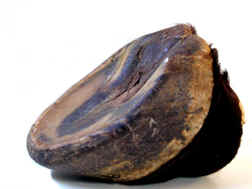
slb - thanks for your explanation. I will have him take the 4th nail out next time, it’s the only holding the traction nail for ice. I talked him into it the last time… I need some good traction in this ice or I’ll end up with a busted ankle, but good feet.
I will also push for more toe off - how agressive can one be with toe removal as a general rule? The horse can bleed if cut back too far, right?
So basically - if I have this correct, the foot will grow differently - grow into a proper heel like you last posted a picture of… if the foot is simply trimmed “balanced”? Easier said then done, right? ![]() But good knowledge.
But good knowledge.
Thanks to you and hoss and any other knowledgeables for all your time spent on this thread - I think it might be enlightening a lot of people.
martha
Ok, since I don’t know when the farrier (my husband) will have time to trim, I have gathered some pics to show you what a balanced foot looks like.
First is a side view that shows a mustang foot and foot trimmed in a natural balance trim to emulate the mustang foot. The domestic foot is most likely prepared to apply a shoe to, thus the quarters are not relieved (or floated). Notice the straight horn tubules and hairlines, and the tight appearance of the healthy hoof wall. The mustang foot has a natural roll to the entire edge…sometimes called a mustang roll. This is from an abrassive terrain and doesn’t happen on feet that are on softer ground. However, generally, the toe will be rolled and the quarters relieved regardless of the terrain. The domestic foot is a work in progress and therefore not perfect. Notice the bevel on the bottom of the toe…that is the one that I noted earlier as being cut from the bottom upward and is used to enhance breakover. It is emulating the toe roll on the mustang.
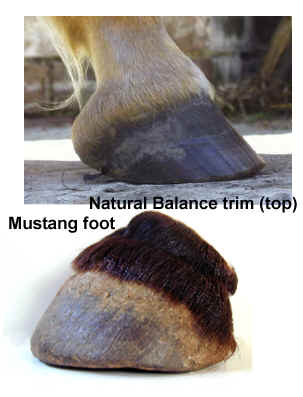
This is the only pic of my horse’s feet that I have. For once in my life, I have been blessed with a horse with good, sound feet. Our farrier is pretty good too. He is standing a little funny in this pic…he must have been eating the bushes ont he other side of the hitching rack ![]()
[I]March 14th 2003. D(idi)-Day
Centre Equestre de la Houssaye[/I]
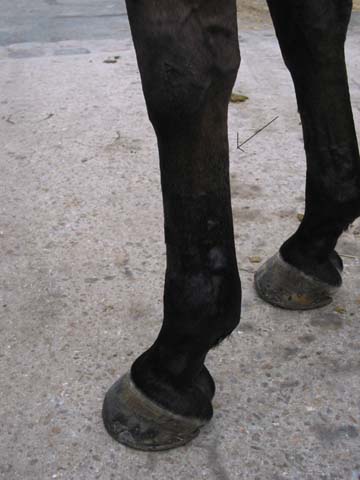
Right hind
Valerie
~VWiles02@yahoo.com~
UC Davis student
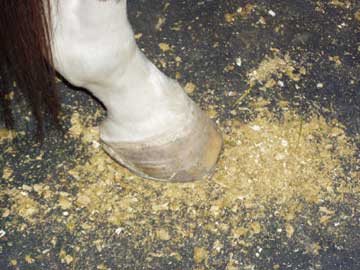
Comeon kids…I’m not going to say which pro did this until I get somemore input! ![]()
Even if you don’t feel that you are knowledgable enough to comment, just say if you like what you see or not and maybe why…just curious about what people think about this type of trim. ![]()
Katarine, those crooked legs are tough when the foot gets away on ya.
I’m with slb on the toe etc. About the shoes being off, I’m a real big fan of pullin them and turn’em out and close your eyes.
Sure they will abcess a lot, but after awhile you have a foot you can work with. Circulation gets better, and the over all tone of the foot gets healthy.
When I buy OTTB’s by the truck load at the end of the racing season, first thing I do is yank off the shoes and turn 'em out in the feed lot. They struggle for a month or so, to just to get from the round bales to the water, but it’s amazing how good those feet are after a couple of months.
And low and behold there are a few sound ones.
If those crooked legged horses were out in the wild , nature would look after the problem.
Regards J.
Here’s a couple of feet that might give you a clearer picture of the long/short idea.
I can’t remember which horse this was but it’s a new one cause the nails on the shod foot sure aren’t mine. I tend to drive 'em in as high as they will go. The toe is gone on the other one.

Oh fantastic… i like that pic. It is what i had in mind… it looks at first glance it looks like the heel angle matches the front of the foot angle.
I am assuming this is the goal.
Thank you. ![]() I will observe it some more, and maybe compare it with lines to my java foot so i can see the specifics…
I will observe it some more, and maybe compare it with lines to my java foot so i can see the specifics…
![]()
Ok, I’ve observed with pictures. I think, based on what I’m learning… that this picture is a great side-by-side of what underrun heels means, compared to what’s right. Correct?
If so, then I think this is what all of us more ignorant folks need to look at.
In fact, I believe the definition of underrun, based on what I’m learning, is specifically that the heels are a much more horizontal slope/angle then the hoof… as illustrated. If that’s the case, that really clears this up for me at least as far as having an educated eye.
I actually have some more questions about the nature of underrun heels and how they become corrected… but I will wait for comments on the images and discussions above before I throw more into the pot…
martha
[This message was edited by mcmIV on Jan. 06, 2003 at 05:29 PM.]
[This message was edited by mcmIV on Jan. 06, 2003 at 05:32 PM.]
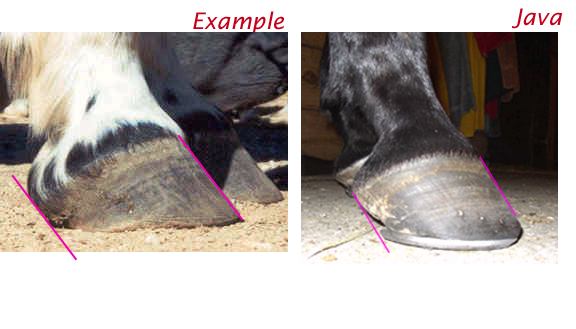
wow! That was one helluva gauge!
Wondering if anybody has any opinions on this–4 year old TB, has had a rank nasty Quarter crack for almost a year. FINALLY getting some foot to grow–previously there wasnt enough to even get a shoe on for support.
Any opinions about treatment?
A little nonsense now and then, is relished by the wisest men…
FairWeather
CANTER West Virginia
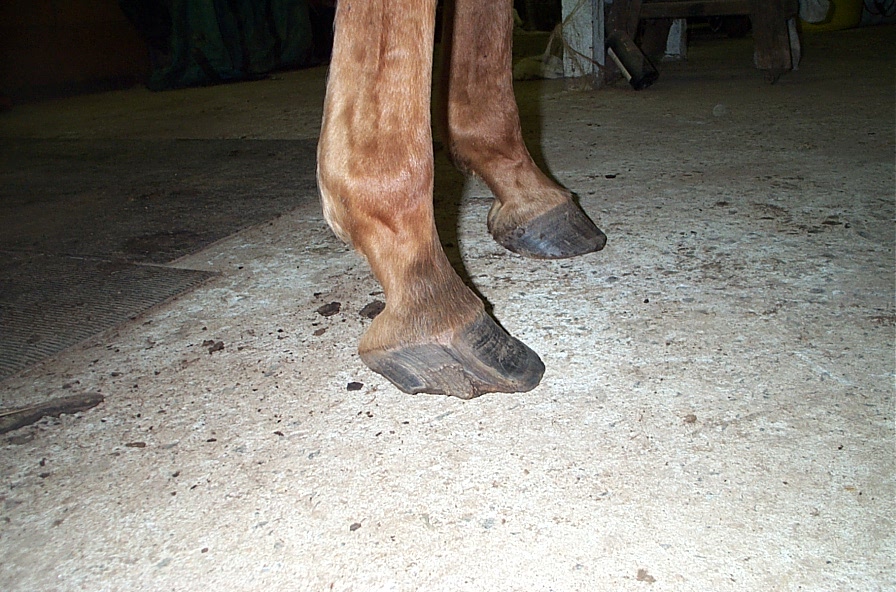
Here’s the front view.
disclaimer I didn’t put a lot of thought into the taking of these pics, sooo they are far from being taken at the perfect angles ![]()
— And how did you feel about being denied these Hungry Hippos?
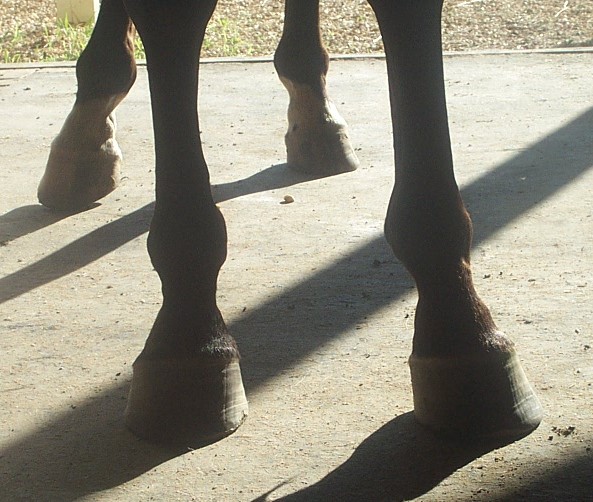
great idea!
I have BAD pics of feet–of my mare before we started trying to get them back to normal. Silly me thought they WERE normal until I learned better.
I’ll get pics of my boys’ feet–all three different, but I think all healthy and decent. Marks feet are a little screwy, but then again, he’s a little screwy ![]()
Ditto on the mud.
